


The Italian high fashion showings began yesterday with Wanver, Coccoli, Nativo, Rosati, Siviglia and Bazzarini showing men's wear. The overall trend was towards a more masculine man.
Vents in the back of jackets have been eliminated in many models, and hats are a big thing for men, in fur or in cloth. There is a great variety in shoes. Some went as high as two inches with the heels and others featured a high and round mound on the toe.
Colors were in the typical winter styles of grey, blue and brown although some pastels were around, Fabrics were mostly wool and artificial fur.
Siviglia's collection was filled with show stoppers. He began with men's maxicoats that fell to just above the ankle and were worn with frier's hats. Gowns in gold, silver and whitr went tp the floor and were so straight in line that the young men modeling them literally had to pull up their skirts to get down the runway. For evening he favored black satin suits with belts to match the boutoneers.

The collections were shown last night as men's fashions made their first appearance at the current show at the Pitti Palace. They included those of top Italian designers and, judging by their view of men's wear trends, ties, lapels and even buttons are rapidly dying out.
The earrings were gold or silver rings by Tommy Caraceni of Milan and were worn with silken puffy sleeved Romeo shirts.
The necklaces and bracelets were huge barbaric looking bands of glit or leather edged with gilt from the collection of Mr. Kirashev's tailor, Ultrica.
Jackets are easier, often cut like narrow shirts or judo jackets, sometimes zipped up the front, usually worn with heavy leather belts. Other times they are sweater or tunic shapes.
Padded shoulders and stiff lapels were in a distinct minority.
Shirts, too, had a bard time of it — the newest look was a wide expanse of hairy chest clothed with nothing but pendant and chain.
Ties gave way almost everywhere to scarves or shirts with built-in cravats.
Filippo nativo showed strip-tease jacket the bottom half of which unzipped round the waist, leaving the top half to make a one-piece bellboy costume with the trousers.
Mimmo Siviglia, one of the best tailors in Rome, brought the house down with a take-off of the madder designs of his colleagues, particularly Valentino.
His models flapped bare-footed down the runway in huge shapeless pajamas, ponchos and capes, a cruel parody of Valentino's fashions for the idle rich.
The audience rocked with laughter as wild apparitions dressed as Arab sheiks or pirates lore round the salons flapping their raggy black clothes.
Far more gentlemanly were the models of Florentine designer Emilio Pucci, wearing jackets in toned down versions of his famous psychodelic prints and handing out roses to the women in the audience.
The most colorful, however, were Ken Scott's, who wore blinding rainbow-coloured velvet suits in all exotic shades from shocking pink to arsenic green. --NZPA-Reuter.
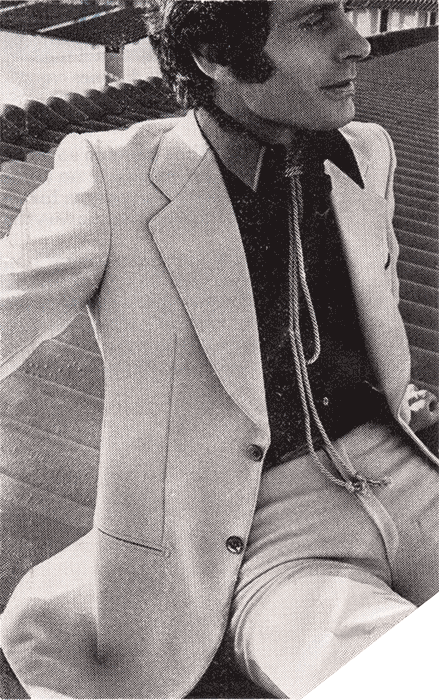
________________
The Rome collections have been shown and designers appear to be unanimous in their prediction that this Summer clothes will take a definite swing towards elegance and comfort -- something which has been drastically missing in previous years.
To help achieve this effect the use of natural fibers, such as wool ], cottom and silk, are predominant and colour and cloth are carefully co-ordinated to create a total look.
Styling is casual. The suit remains much the same but for the exaggeration of detail in the width of collar and lapels and the length of trousers which fall over the shoe heel to the floor.
The popularity of the shirt suit and co-ordinating tops and trousers shows yet again the increasing demand for a confortable elegance, and even evening wear rejects the classic dinner suit in favor of delicately moulded wool crepe suits which, when worn with matching crepe or silk shirts, portay a much warmer and softer image.
Colourwise, designers are undecided. Many are predicting the strong vivids, using a lot of kingfisher blue and a cross between a fuschia pink and purple in their ranges. Others, however, rely for their impact on the unusual combination in men's clothing of pastel coloured geometric designs on a plain white ground.
________________
Single-breasted two-piece suit in sand coloured wool crepe. The jacket has large lapels and is cut without a vent and the trousers have two-inch cuffs and reach over the shoe heel to the floor. Designed by Siviglia.
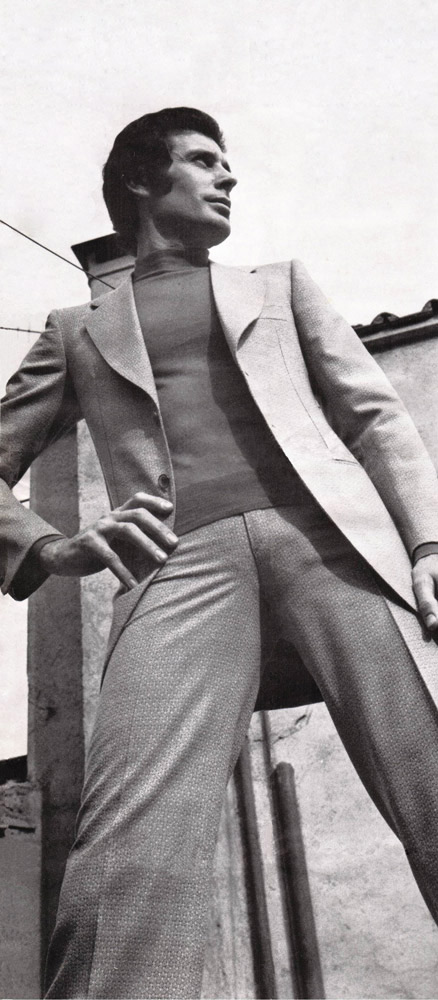
________________
Fedele a se stesso, Siviglia non ha rinunciato alla sua fantasiosa presentazione, quasi un pirotecnico bengala. Per lui, le creazione per la sfilata sono un gioco della fantasia. Non mai del tutto gratuito tuttavia, si in ogni presentazione offre qualcosa di razionalmente nuovo: suggerimenti che in più di un caso la moda, prima o poi, ha finito per acettare.
Del Siviglia sarto, nel senso tradizionale del termine, appena qualche esempio, quasi a testimoniare la sua capacita e padronanza del mestiere.
Temi dell’attuale sfilata: completi per pioggia, con sahariana, in neplax nero; maxi impermeabili di tela di vela e vinile; scialli con frange, tuniche accappatoi per il mare; tuniche ancora per la sera; casacche, bluse con maniche a sbuffo ecc.
Tessuti Rhodiatoce, Bemberg (Bemberg anche tutte le fodere), Lanifici A. Pria, E. Zegna, Fratelli Tallia di Delfino, Fabbriche Ruinite.
________________
Uno del pochi modelli de linea tradizionale presentati da Siviglia nella sua sfilata. Completo con giacca monopeto a due bottoni, di vite alta, dai caratteristici risvolti. Tessuto del Lanificio E. Zegna di color marrone chiaro, disegno a squame di pesce.
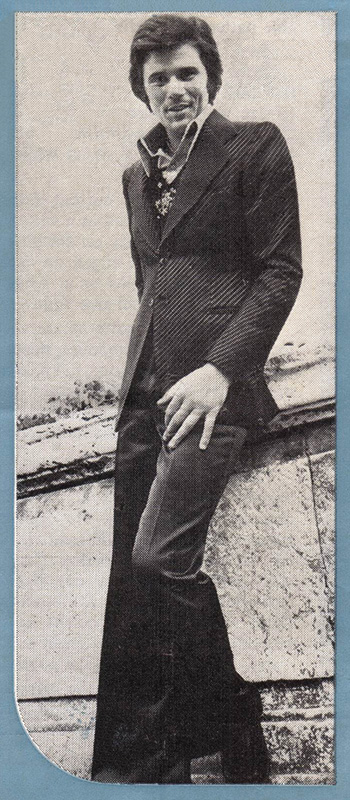
ROME's couture shows for autumm-winter 1972-72 broke with tradition by leading off with a showing of men's fashions instead of the usual women's clothes — a move towards men's lib?
Although the first collections were by the up-and-coming "young" designers, Bazzarini, Coccoli, Nativo, Rosati and Siviglia, with few exceptions the trends were back to "classic" lines. Changes were rung by details in cut or by preferences for brightening dull autumn-winter days with gay colours and bold checks. And the design went back to every well-tried style on recent history, so that there was something for everybody.
Jackets were single- or double-breasted with one, two, four and six buttons and varying shapes and sizes of lapels. For width, Rosati's lapels were unsurpassable, almost touching the shoulders. Most trousers were high-waisted, snug around the hips and tapering slightly outwards towards the ankles. Coats were mostly knee-length, single-or double-breasted, with tie-belts, buckled belts or belt-less.
________________
Dress-down black on black wool-silk evening jacket diagonally striped in velvet. It has s.b. button-two fastening, wide pointed lapels, slit side pockets, welted breast pocket and deep side vents. Worn with black wool flareline trousers. From Siviglia.

FASHION'S flirtation with the fifties is influencing men's wear styles as well as those for women.
Three designers of men's wear inaugurated five days of couturier collections in Rome recently and the basic wardrobes were strictly classical. All the fun was in the accessories or the unusual colour combinations.
One model wore a sunflower yellow shirt with a deep burgundy jacket, but reminiscent of the 1950s, the trousers were charcoal black. A lime shirt was teamed with sand-coloured slacks and one-button jacket — no lapels — was in deep charcoal with a tiny geometric pattern.
One of the best ensembles was Rosati's sky blue gaberdine suit, worn with a cherry tie and a plain white shirt. The jackets were cut fairly boxy compared with past styles, and the trousers widened below the knee.
One tropical suit in pale cream was worn with a powder blue shirt and a chocolate-coloured knitted tie.
Designers appeared to be preocuppied with the belief that all these grey and cream classic spring clothes could appear rather dull.
As a result, models wore the usual long, carefully-teased and sometimes obviously peroxided hair styles. There are no crew cuts in high fashion, at least not yet.
Men's heels are significantly higher, for the same reason. Boots are out, but platform soles and heels of up to three inches are definitely in and they include black patent or kid versions of evening wear.
Mimmo Siviglia's favourite spring accessory was a hand-knit geranium turtleneck sweater, to be worn instead of a shirt and tie.
Other grey Shetland cardigans were alternatively cut like a men's shirt, with patch pockets at the waist, or had shawl or turtle collars.
Siviglia prefers black for daytime wear in both Spring and Summer.
His narrow black blazers had rows of red overstitching outlining all seams and a padded trouser-bottom instead of a turn-up.
The overstitching motif in evening wear was worked in silver laminated thread — even on a pair of black overalls, worn with black satin shirt with silver plastic collar and cuffs.
His shiny black cire sports jackets had a drawstring band at a raised waistline. Worn with them: A red and black-striped woollen football scarf and matching turtleneck seater.
Bazzarini's formal wear relied for effect on unusual fabrics and the sculptured, cut-away necklines of his evening jackets without lapels. He used pastel tapestry weaves, royal blue embossed silk and pale pastel plaid wood for dinner jackets worn over charcoal black trousers.
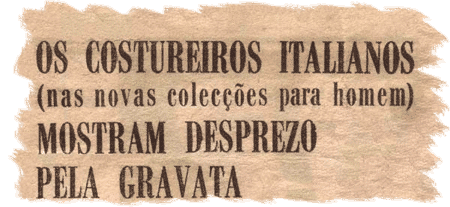
ROMA (ANI) — As combinações de branco, cinzento, vermelho e negro dominam a colecção de roupa masculina que o desenhador italiano Mimmo Siviglia apresentou num hotel de Roma para a Primavera, o Verão e até, mesmo o Outono.
As calças cobrem os sapatos e os casacos têm ombros quadrados e bandas largas, mas as gravatas não aparecem na moda proposta por Siviglia, que utiliza as camisolas de gola alta e as camisas de colarinho desapertado.
Este costureiro recorre a pespontos contrastantes para sublinhar os ombros, as bandas e outras zonas do fato.
Mimmo Siviglia combina longos casacos de malha branca com calças brancas e sugere fatos de lã shetland cinzenta, nomeadamente com cinto, que parecem roupões de banho.
Bazzarini e Rosati, que apresentaram as suas colecções no mesmo hotel, mostram-se muito mais tradicionais.
No entanto, Bazzarini compartilhou o desprezo pela gravata: mostrou camisas de colarinho aberto, nomeadamente cor-de-laranja e doiradas, por vezes com um lenço ao pescoço.
Rosati conseguiu fortes aplausos para os seus fatos de seda pura, e apresentou predominantemente tons cremes e castanhos, não se esquecendo dos jaquetões.

As calças cobrem os sapatos cinzento, vermelho e negro dominam a colecção de roupa masculina que o desenhador italiano Mimmo Siviglia apresentou num grande hotel de Roma, para a Primavera, o Verão e até, mesmo o Outono.
As calças cobrem os sapatos e os casacos têm ombros quadrados e bandas largas, mas as gravatas não aparecem na moda proposta por Siviglia, que utiliza as camisolas de gola alta e as camisas de colarinho desapertado.
Este costureiro, um dos mais apreciados da Itália, no que diz respeito à moda para homen, recorre a pespontos contrastantes para sublinhar os ombros, as bandas.
A colecção apresentada, toda ela de corte impecável, engloba um fato preto com botões vermelhos e una camisola vermelha.
Mimmo Siviglia também combina longos casacos de malha branca com calças brancas. E sugere fatos de lã <<shetland>> cinzenta, nomeadamente com cinto, que parecem roupões de banho.
Bazzarini e Rosati, que apresentaram as suas colecções no mesmo hotel, mostram-se muito mais tradicionais.
No entanto, Bazzarini compartilhou o desprezo pela gravata: mostrou camisas de colarinho aberto, nomeadamente cor de laranja e doiradas, por vezes com um lenço ao pescoço.
Rosati conseguiu fortes aplausos para os seus fatos de seda pura, e apresentou predominantemente tons cremes e castanhos, não se esquecendo dos jaquetões.
Na colecção Brioni e Coccoli, a linha é sóbria. O regreso ao clássico, iniciado na estação fria, comfirma-se: ombros no lugar, casaco não cintado, calças de corte amplo com dobra, prespontos, alguns bolsos plissados, um estilo tranquilo e equilibrado. Para os mais frívolos os pormenores não faltam: vêem-se nomeadamente sapatos ortopédicos de saltos como os que que fizeran juror entre <<elas>> e que tornam o <<elegante>> algunos centímetros mais alto.
Para as senhoras, embora a dendência geral seja para o clássico, Roberto Cappucci faz plissados em todos os sentidos. Pequenos vestidos princesa, casacos de bandas verticais multicolores evocando o plissado, mas tambén plissados em <<epiecements>>, blusas e vestidos inteiros. Para a noíte, o austero vestido-túnica com o pescoço cercado por metal <<dourado>>.
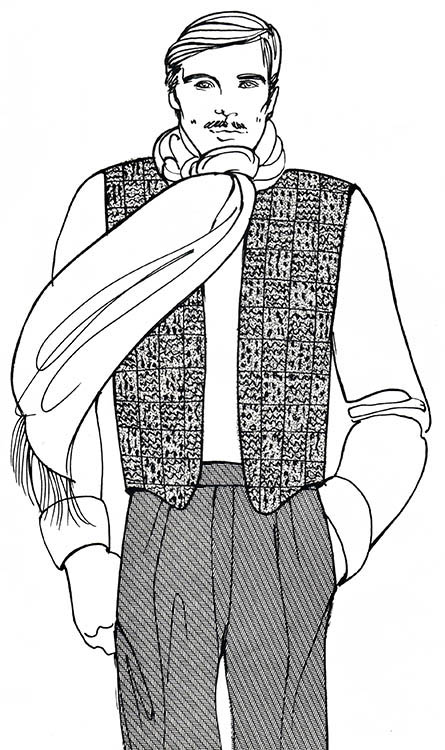
Replacing jackets came BIG, BULKY TWEEDY KNITS with loads of SURFACE TEXTURE to delight the eye. These were sophisticated translations of the MEXICAN CARDIGAN with that veru special ROME imprint.
________________
Greasy wool in natural gray, replaces the waistcoat as a viable alternative, at Siviglia.

ROME (Reuter) — The feminine overtones have disappeared from most of men's fashions, to judge by the spring and summer collections introduced in Rome thid week by six Italian high-fashion designers.
All the ruffles that used to be standard fare for men's collections shown on the catwalk — lace-trimmed shirts, bulky costume jewerly, handbags to match the fabric — have been set aside.
The theme is the 1930s as in the mannered recreation of the period by Roman Polanski in the recent film "Chinatown." The all-white summer suit with loose-fitting trousers worn by the film's hard-boiled detective was faithfully reproduced in several collections.
Trousers are less snug over the hips, and have both tucks and pockets, the waistband is set considerably higher, while trouser legs tend to flap and, in the case of designer Mimmo Siviglia, have turnups that drag on the floor.
Jackets came with square shoulders, broad lapels, and a loosely fitted, rather high waistline. Back-belt inserts and shoulder yokes were popular.
Wanver's summer shirts in classic shapes came in baby-pink pajama striping, and were teamed with salmon-pink trousers.
The show stopper was Siviglia's loosely fitted, one-piece Red Baron aviator outfit in all-black glazed cotton. Loose trousers were rolled up to show fitted black boots.
A foot-high elastic cinch belt, a hand-woven emerald-green mohair scarf, and a matching emerald crash helmet completed the outfit.
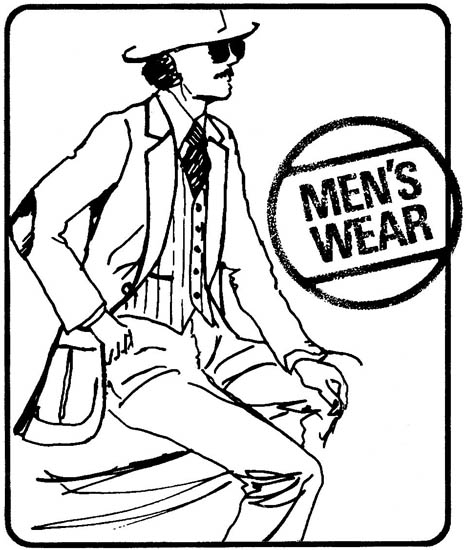
The Man in Wool programme incorporates new styling and fashion trends from leading international designers and these are passed on to makers-up and retailers.
This drawing from the Roman designer Mimmmo Siviglia is one of many commissioned each season by the International Wool Menswear Office in order to keep IWS [International Wool Secretariat] branches up-to-date on changes in men's clothing shapes and textiles.

Two thousand years ago, when its empire stretched from Britain to Egypt, Rome was the capital of opulence—a place where the finest raw materials and the most talented craftsmen came together to create the world’s most sought-after luxury goods. Today, the world still looks to the Romans for premier ateliers, from fine art to fine food to—most especially—fine fashion and accessories.
Rome’s gifted tailors have been dressing the city’s upscale residents and visitors for centuries, and the tradition has not faded. The city’s small, client-oriented boutiques, many of them owned and operated for generations by the same family, still create custom garments using timeless techniques. The boutiques most worth visiting may be the least well-known to those who do not live in Rome, according to Petulia Melideo, a native Roman whose family have participated in textiles and fashion for generations.
"Most fashion artisans’ shops are in lesser-known parts of the city away from the tourist sites," says Melideo. "They don’t usually have a sign on the door, and few are listed in the phone book, let alone on the Internet!"
Sirni Pelleteria, at its current location since 1950, provides an excellent example of the family-run bespoke fashion tradition in Rome, according to Melideo. Brother and sister Andrea and Rita Sirni create custom leather accessories at Sirni Pelleteria just the way their father taught them (and his father taught him). Rosanna Sirni, their mother, still follows each item’s progress from the time a client chooses the leather and colour of the piece to the moment she adds its finishing touches. Handmade bags here range from approximately €280 to €1000.
Lovers of hats and history should consider a visit to another venerable Rome institution. Still in its original 1936 location, with furniture and equipment intact from the days when the Cirri family created beautiful hats for the men, women and children of Rome, Antica Manifattura Cappelli is an old Roman favourite operating under a new name and now run by the family Fabri. The shop could be considered something of a fashion museum, except that it is still in active operation today, specializing in "single piece" creations and still practicing many of the traditional hat-making methods.
Another notable Roman artisan is master shirt-maker Mimmo Siviglia, who began his work at the ripe age of five, observing master tailors at work in his native Calabria. "He worked with Armani before anyone had ever heard of Armani," says Danielle Pollack, who works with Melideo, "and his distinctive pieces have appeared in Men’s Wear, Harper’s Bazaar and Vogue for Men." Despite the lavish praise he has received within the fashion universe, Siviglia remains most interested in catering to individual clients in a highly personalised manner. For first-time clients, the minimum order is three custom shirts, with prices beginning at €100.
For more information on specialised fashion tours, contact Centurion Concierge.
Sirni Pelleteria
Via della Stelletta 33
+39 06 68805248
Antica Manifattura Cappelli
di Patrizia ad Piercarlo Fabri
via degli Scipioni 46
+39 06 39725679
Mimmo Siviglia
Via Urbana 14a
+39 06 48903310

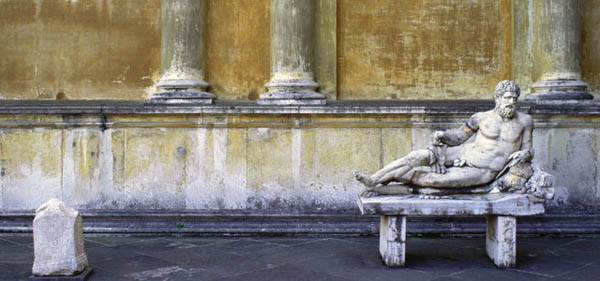
In one of Rome’s oldest neighborhoods is the custom shirtmaker Mimmo Siviglia. For almost half a century, Siviglia has been making bespoke shirts for men and women out of the finest Italian cloth. His small shop has brightly painted yellow walls and shelves lined with bolts of fabric—from pastel-colored Egyptian cotton to twill and flannel. You will have to have two fittings and must order a minimum of a half dozen shirts, but once they have your form down (assuming it stays the same), you can order and he will ship anywhere in the world.
© 2007 Indagare Travel, Inc. All rights reserved.
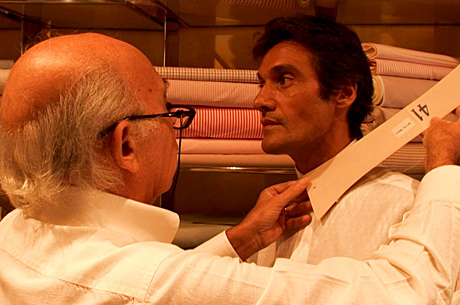
“良いシャツ”の見わけ方
店主のミッモさんにお会いしてビックリ。
彼は世界的に超有名なデザイナーだったのです!
その逸話もスゴイ。
あのアルマーニが、かつてミッモさんのモデルを務めた時、言ったそう。
(アルマーニはデザイナーになる前にモデルをしていた)
「あなたのコレクションには、この先10年分のアイディアが入っている。
だから、もし私がデザイナーになっても、何もすることがありません。」
ミッモさんが“デザイナー・アルマーニ”の誕生を阻むところでした、危なかった~。
ミッモさんは、体調を崩してトップデザイナーを引退。
再びファッション界に戻る時、彼が選んだ道は、小さなオーダーメイドシャツの専門店。
だからこそ、と~っても穴場なんです!
Rione Monti
Via Urbana,14/A
ミッモさんが教えてくれた“良いシャツの見わけ方”。
1. 縫い目が細かい(布が上質でなければできない技!)
2. 襟の首後ろ部分が薄い(厚ぼったい芯を入れて作った襟はダメ!)
3. 袖口のボタンをはずしても形が崩れない
(半袖のシャツはエレガントじゃない!
暑い時は、長袖の袖口をはずしてシャツを着るのが伊達男。
だから、ボタンをはずしてダラ~ンと形が崩れるシャツはダメ!)
バックナンバー
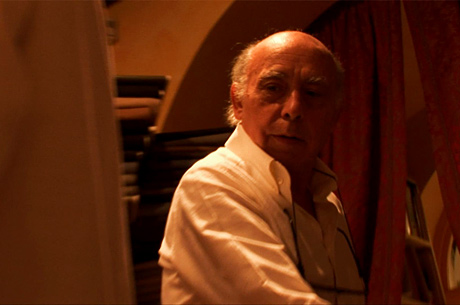
本場ローマの「カルボナーラ」
イタリアの“食堂"、トラットリア。
星の数ほどありますが、その分「ハズレ」も多い!
“給食のソフト麺"のようなパスタもありましたからー。
「ソーラ・マルゲリータ」のように、毎朝手打ちのパスタを打つ店は、
ローマといえども、希少価値かもしれません。
Piazza delle Cinque Scole 30
ところで、「カルボナーラ」。
ローマで生まれた料理だってご存じでしょうか。
ロマーナのコーディネーターが教えてくれた、本場カルボナーラの作り方です。
1. 全卵1個、卵黄2個(3人分)をよく溶きほぐす
2. パルメザンチーズ、ペコリーノチーズ(ローマのチーズ!)をすり下ろし、
溶いた卵に混ぜ合わせる(目安として「各チーズ大さじ2~3くらい」、お好みで!)
3. パンチェッタなどのベーコンを、オリーブオイルで炒める
4. 茹でたパスタを入れ、合わせる
5. 火を止めて、卵&チーズ(2)を入れる。
6. コショウをふり、必要なら塩で味を調整してでき上がり!
生クリームを使わないのが、本場ローマ流なんです!
〈ボルサリーノが似合う仲村トオルさん!〉
それでは撮影を・・・と、ボルサリーノの帽子を初めて手にした瞬間、
「それはもぅー、ビックリ!!」
うさぎの毛から、完全手作業で作るというフェルトの、やわらかいこと!軽いこと!美しいこと!離したくないあの手触り!
たちまち欲しくなってしまう、キケンな魅力の帽子なのです。
ボルサリーノを愛する、フレッド・アステア、ロバート・レッドフォード、フランク・シナトラ、アラン・ドロン、ジャン・ポール・ベルモンド、フェデリコ・フェリーニ、ゴルバチョフ、そして昭和天皇・・・などなど。
みなさんのお気持ち、大いにわかってしまいました!
さて、撮影も終わり、スタッフの気持ちは当然・・・
「ボルサリーノの帽子、すっごく欲しいぃ~!!!」
でも、お値段も一流なんです。
「Fedora(フェドーラ)」 297ユーロ(ロケ当時 約\49,000)
「Panama Hat(パナマ)」 602ユーロ(ロケ当時 約\99,000)
*放送中の商品から一例
当番組の伊達男、仲村トオルさんへ、番組ラストに登場した「牛革のグローブ」をおみやげに。
ダークブラウンの艶やかなグローブ、これが似合うのは・・・
上質なスーツを着た紳士か、イタリアンマフィアか、といった“極上エレガント"。
はたして仲村トオルさんはどうか!?
無地のTシャツにジーンズ姿の仲村さん・・・なのに(?)、これがよく似合うこと!存在感抜群だったグローブが、一瞬にして仲村トオルさんの一部に。
“本物の男だけが似合うボルサリーノ"、本当でした。
「ありがとうございます!」と極上の笑顔でグローブの感触を確かめる仲村トオルさんこそ、“本物の伊達男"でした。
Piazza del Popolo,20
(ポポロ広場に面しています)
〈遺跡の街で“ローマ数字"を楽しむ!〉
靴を見れば、観光客か?ロマーニか?わかってしまうかもしれません。
古い石畳だらけのローマ。
歩き馴れない観光客は、ペッタンコのサンダルや運動靴。
地元っ子は、ハンドメイドの革靴で、良い靴音を響かせて歩くんです。
とくに女性は、ヒールのかかとが石畳にハマりまくっても、負けじとガンガン歩く。
靴みがき職人・ロザリーナさんは、そんな靴の国・イタリアの駆け込み寺です。
Via in Luchina,16
ローマは古い!
まさに街全体が遺跡です。
何の気なしに歩いている石畳(古代ローマ時代!)、滞在した宿(16世紀!)、
そこら辺にある噴水(紀元前とか!)・・・ どこを撮っても絵になります。
建物をよく見ると、建造された年が刻まれてたりするんです。
例えば・・・
「MCCXXXIV」
何年かわかりますか? 答えは「1234年」。コレ、ローマ数字なんです。
Mが「1000」。
Cが「100」で、2つだから200。
Xが「10」、3つで30。
Vが「5」で、左にIだから、IVは「5-1」で「4」。
では、これは?
「MMCXXXV」
答えは・・・・「2135」でした!
〈ヴェスパ好きに悪い人はいない!?〉
終戦直後に誕生し、イタリアの復興と共にあったヴェスパは、
スクーターである以上に、イタリア人の魂そのもの。
イタリアの多くの人が、本当にヴェスパを愛していることがわかりました。
ヴェスパレンタル店:「Cyclo」
Via Cavour 80/80A
Via Salaria,239
今回の撮影、“街を走るヴェスパを待ちかまえて撮影する作戦"だったのですが、そう上手くはいきません!
カメラが待っている目の前に、上手く走ってきてくれるはずもなく・・・、やっと来たかと思えば、でっかいバスがカメラ前を阻んだり・・・。
ならば、どうやって撮影したか?
“もう一度走り直してもらった"んです。
たまたまヴェスパに乗って、我々が撮影している場所を通りかかっただけなのに、どこかへ向かっている途中であろうに・・・
誰も彼も皆、快く走り直してくれるんです!本当に良い人たちばかりで感激!!
「イタリア人が愛するヴェスパを撮ってもらえるなら喜んで!」ですって。
極めつけは、「僕の家に1962年のヴェスパがあるから、その方が良いでしょ!」と、わざわざ取りに帰ってくれた、通りすがりの人。
ディレクター的格言。『ヴェスパ好きに悪い人はいない。』
イタリアで困ったら、ヴェスパを探せば道は開けるかも!?
Copyright © 1995-2009, Tokyo Broadcasting System Television, Inc. All Rights Reserved.